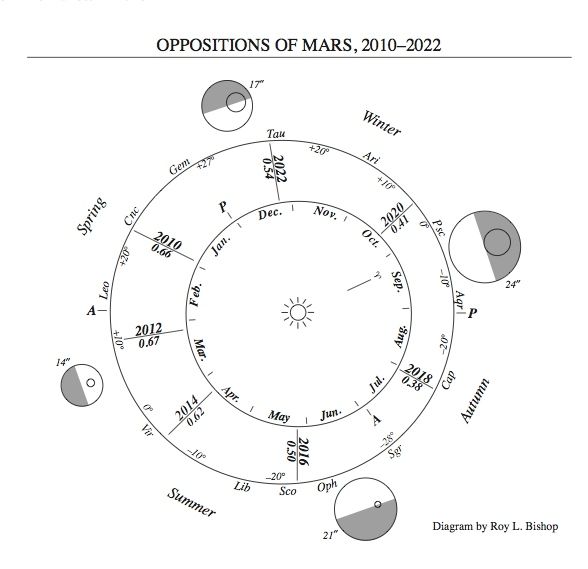
Mars comes closest to Earth every other year, around the time of its opposition, when Earth is sweeping between the sun and Mars. Mars will be at opposition later this month, on October 13, 2020. Yet Mars is closest to us today on October 6, 2020. Why are the dates different? And why will Mars be at its brightest around October 13, although it is closest now? And is now a good time to view Mars through a telescope? For the answers to all of those questions, read this post: Mars closest to Earth on October 6, 2020.
Want to know more about the cycle of close and far Mars oppositions? Keep reading …
Oppositions of Mars are far from equal, and 2020’s is a pretty good one. At its closest on October 6, Mars is about 38.57 million miles (62.07 million km) from us.
Nearly 60,000 years ago – on September 24, 57,617 B.C. – Mars was only 34.62 million miles (55.72 million km) distant. The opposition of Mars on August 28, 2003 – which brought Mars to 34.65 million miles (55.76 million km) of Earth – was Mars’ closest approach since then. The 2003 record for closeness won’t be broken again until August 29, 2287.
In contrast, the most recent distant opposition of Mars – on March 3, 2012 – placed the planet at 62.62 million miles (100.78 million km) away.

Mars is relatively close in 2020 because its perihelion or closest point to the sun happened fairly recently, on August 3. Earth has a closest and farthest point from the sun, too. We’re closest to the sun every January, and farthest from the sun every July. Perhaps you can see that – when Mars is closer to the sun around the time we pass between it and the sun – it’s bound to be closer than usual to us. This effect is accentuated when three events line up:
We pass between Mars and the sun.
Around that same time, Mars is near its perihelion, or closest point to the sun.
Around that same time, Earth is near its aphelion or farthest point from the sun.
That’s what happened in 2003 and, to a lesser extent, in 2018. Astronomers call such events a perihelic opposition of Mars. In 2003, the lineup of the three events listed above was really close! So 2003’s opposition of Mars was very dazzling. The 2018 perihelic oposition of Mars was good, too (though not as good as 2003). And 2020’s opposition of Mars – though not as good as 2018 or 2003 – is still being labeled a perihelic opposition by some Mars observers.
In other words … Mars is bright!

Close (or distant) oppositions of Mars recur in periods of 15 to 17 years. Note that we’re now 17 years past the historically close encounter on August 28, 2003.
Mars’ next extra-close opposition will be September 15, 2035. However, – like the 2018 opposition – it won’t be quite as close as the opposition of August 2003.
Very similar Martian oppositions take place every 79 years (15 + 17 + 15 + 17 + 15 = 79). These 79-year cycles repeat with only a delay of two to five calendar days. The super-close opposition of Mars in the year 2082 will fall on September 1, 2082. But once again, Earth and Mars won’t come as close as they did in August 2003.
There is a more exact cycle of 284 years (79 + 79 + 79 + 15 + 17 + 15 = 284). The Martian opposition that comes 284 years after August 28, 2003, will fall on August 29, 2287. This time around, Mars will come closer to Earth than it did during its close encounter in August 2003.
Because the Martian orbit is becoming more eccentric (flatter), the closest oppositions will actually come closer to Earth, and the farthest oppositions will actually become more distant. The computational wizard Jean Meeus figures that from the years 0 to 3000 A.D., Mars will come closest to Earth on September 8, 2729 (55.65 million kilometers or 34.57 million miles) and farthest away on March 6, 2832 (101.50 million kilometers or 63 million miles). I’d like to see that, wouldn’t you?
Want to know more about close and far Martian oppositions? Visit Spider’s astronomy site.
While the time is at hand, enjoy the close appearance of Mars in Earth’s sky during October 2020! You won’t be sorry you looked for it.
Bottom line: Oppositions of Mars are far from equal. This post explains why Mars has near and far oppositions and shows why the 2020 opposition is a good one.











